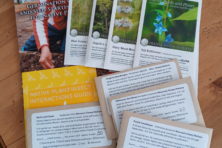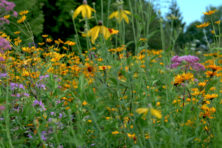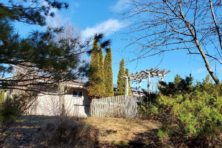Wild Ones: Hold Off on Spring Cleaning
- Share
- Tweet
- Pin
- Share
Finally the day has come – that day when it truly feels like spring. You are so very ready to get outside to prepare your pollinator garden. You’ve planted native trees, shrubs and perennials. You’ve dutifully adopted “messy gardening.” And you’ve offered food and cover for winter birds and overwintering pollinators. Now you’re itching to get outside to get started with spring cleanup.
So pull on those gardening gloves, but then – resist the cleanup urge.
Although there are many productive things a gardener can do at this time of year, it’s best to hold off for now on doing a thorough spring cleanup. Delaying your normal yard care a bit could mean the difference between life and death for insect pollinators, and perhaps even for some migrating birds.
We celebrate honeybees and butterflies, but native bees provide the most effective pollination. With the exception of bumblebees and a few semi-social species that live in small colonies, most bees – an estimated 90% of Wisconsin’s bees – are solitary. A surprising number of these extremely beneficial pollinators are probably nesting in your garden or yard.
In Wisconsin, we have hundreds of species of native bees, some of which look nothing like the honeybees we know and love. Not all overwinter, but many prepare a brood nest in the fall, stock it with a mixture of pollen and honey, then lay eggs. The young emerge in spring.
Brood nests vary considerably. Some bees create them underground, and others search for holes in dead trees or fallen logs. But a number of pollinating species excavate their brood nests in soft or rotten wood, or in the pithy stalks or hollow stems of last year’s flowers.
Also, many of the dead leaves in your yard may be sheltering cocoons and chrysalises of butterflies. Even though they may be “ratty” looking, cutting last year’s dead stalks before it gets warm will wipe out the next generation of pollinators.
And those accumulations of soggy, dead leaves around your yard? They’re crawling with tiny insects: survival food for ground-feeding migrating birds such as towhees and fox sparrows.
Ideally, spring yard cleanup should not begin until the daytime temperatures are consistently in the 50s. That said, when it feels like spring, folks want to work outside. I know I do. And fortunately, there are several appropriate, helpful chores you can complete with that good energy.
One is to clean up the mountains of spilled bird seed and hulls under your bird feeders – and for more than merely aesthetic reasons. These accumulations don’t seem to be harmful in freezing temperatures, but in the spring, soggy seeds can get moldy and become a good medium where pathogens can thrive.
This problem is exacerbated by birds’ rather unhygienic practice of relieving themselves as they eat. Currently on the West Coast, for instance, tens of thousands of songbirds are dying from salmonella poisoning that is apparently being spread by sick siskins leaving infected droppings at bird feeders.
Once you see green shoots in your flower beds, it’s probably OK to gently rake decaying leaves – the heavy, matted ones such as oak – away from your crocuses and daffodils, but just move the dead leaves out of the way. They don’t need to be stuffed into plastic bags. Lighter leaves, whether chopped or not, make a good mulch. When those migrating songbirds arrive soon, they’ll appreciate an all-you-can eat banquet in the backyard, garden or compost pile.
The remains of last year’s sunflowers, cone flowers, goldenrod and asters will look tidy if you cut off the tops but leave about 15 inches of stalk. Later, after the pollinators emerge, you can cut the stalks back, but you really won’t need to because new growth will hide them soon enough.
Have faith that your garden will soon be full, and if you hold off on spring cleanup – just a few more days – beneficial pollinators will make your yard their home.
Coggin Heeringa is the president of Wild Ones of the Door Peninsula and the program director and naturalist at Crossroads at Big Creek in Sturgeon Bay.





